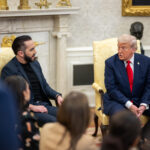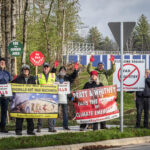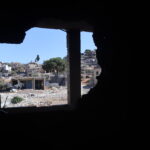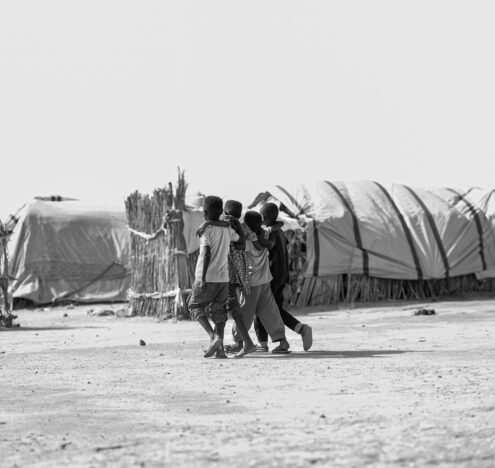From the runways of Paris Fashion Week to the bikini and statement tee, fashion has long been influenced by nuclear weapons. But you’ve probably never thought about this connection. Why would you? First of all, it’s a pretty bizarre correlation. But, on top of that, studies have found that people generally try to avoid thinking about nuclear weapons, due to a very real process called “psychic numbing” where sympathy declines as casualties increase.
This year has been a tough one, though, to avoid thoughts of nuclear war, between shocking comments about “fire and fury,” a nuclear button measuring contest with North Korea, the Putin-Trump Summit in Helsinki, and all caps tweets threatening that Iran will “SUFFER CONSEQUENCES THE LIKES OF WHICH FEW THROUGHOUT HISTORY HAVE EVER SUFFERED BEFORE.”
Fashion designers who lived during similar periods of increased risk of nuclear war have poured this encompassing fear into their creative processes. The traces of their impact on our everyday lives have been largely forgotten but, once remembered, it’s easy to see how often they pop up in each outfit change.
In 1946, Parisian engineer Louis Réard was working at his mother’s lingerie shop in the South of France. Due to post-war rationing, fabric was a commodity difficult to find. With scarcity as the mother of creation, Réard created the first modern bikini.
Due to its shocking nature, Réard named his “four triangles of nothing” a “bikini” after the Marshall Islands Atoll that the United States had targeted only days earlier for nuclear weapons testing. These nuclear tests not only decimated the environment, but left the native people of the Marshall Islands with radiation-related health issues that have been passed from generation to generation.
The stunt and the media attention that followed made Hamnett’s political t-shirts into must-haves, and the concept was replicated en masse.
Adding to this trend, either consciously or subconsciously, one of Victoria’s Secret most popular bikini and bra lines is called the “Bombshell Collection” – a term that didn’t come into popular use until World War II. From its military use to its synonymy with sexiness, the term “bombshell” is an example of how a history of violence lies underneath much of our language and clothing.
A hidden history of fear of nuclear weapons lurks behind the creation of even our more obviously political clothing. In fact, political slogan tees originated with the anti-nuclear movement.
In 1984, British fashion designer Katherine Hamnett was invited to a reception at Downing Street. She wore a t-shirt of her own design with “58% DON’T WANT PERSHING” written in large black font on a white t-shirt, an anti-nuclear weapons statement about the Prime Minister’s decision to allow US Pershing nuclear missiles to be stationed in Britain.
“That t-shirt gave me a voice,” Hamnett said to Harper’s Bazaar, and the public agreed. The stunt and the media attention that followed made Hamnett’s political t-shirts into must-haves, and the concept was replicated en masse.
Fashion’s entanglement with nuclear weapons is not relegated to the past; if anything, a temperamental US president with unchecked sole authority to launch a weapon at any moment has spurred a resurgence of this motif. Growing fears often pushed to the back of our minds have jumped, once again, to the forefront of global consciousness.
Paris Fashion Week is known for its unique, highbrow designs meant to provoke headlines, but for the past two years it has featured an unusual number of shows with the same dystopian theme. In 2017 multiple fashion lines incorporated Hazmat gear, and Calvin Klein models stomped down the runway covered in popcorn which Fashionista magazine said could be “an interpretation of nuclear ashes.”
This year’s Paris Fashion Week was no different. Multiple runways featured allusions to nuclear apocalypse. The Tuba Ergin show began with a video of models walking through a wasteland donning glamorous dresses and gas masks before the models appeared on the runway. Rick Owens showcased his “Babel” collection as models walked around a flaming tower. Ottolinger brought an odd lightness to the theme, with critics describing the collections as “Post-Apocalyptic Rave.”
The fact of the matter is, nuclear weapons will not go away if we ignore them. Turning to recognize the ways in which nuclear weapons are present in our everyday lives can help to make sure this year’s Paris Fashion Week designs don’t become “ready to wear” in Spring 2019.
Samantha Blake is the Women Legislators’ Lobby Program Manager at Women’s Action for New Directions (WAND), which works to build women’s political power to shift the militarized, patriarchal culture that pervades our society and leads to endless war and violence. WAND recently launched their #DisarmThePatriarchy handbook to teach young women what they can do to save the world from the devastation of nuclear war, at disarmthepatriarchy.org.



















